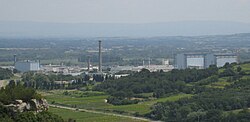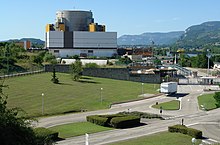Nuclear
| Name | Location | Coordinates | Type | Capacity (MW) | Entered operation | Notes | Photo |
|---|---|---|---|---|---|---|---|
| Belleville NPP | Belleville-sur-Loire | 47°30′38″N2°52′34″E / 47.510534°N 2.8761864°E | PWR (pressurized water reactor) | 2,620 (2 x 1,310) | 1987-1988 | Reactor supplier Framatome T/G supplier Alstom |  |
| Blayais NPP | Braud-et-Saint-Louis | 45°15′21″N0°41′35″W / 45.255833°N 0.693056°W | PWR | 3,640 (4 x 910) | 1981-1983 | Reactor supplier Framatome T/G supplier Alstom |  |
| Bugey | Saint-Vulbas | 45°47′54″N5°16′15″E / 45.798333°N 5.270833°E | PWR | 3,580 (2 x 910, 2 x 880) | 1972 (retired 1994) | Reactor supplier Framatome T/G supplier Alstom and one 550 MW GCR reactor was retired |  |
| Cattenom NPP | Cattenom | 49°24′57″N6°13′05″E / 49.4158°N 6.2181°E | PWR | 5,200 (4 x 1,300) | 1986-1991 | Reactor supplier Framatome T/G supplier Alstom |  |
| Chinon NPP | Avoine | 47°13′50″N0°10′14″E / 47.230556°N 0.170556°E | PWR | 3,620 (4 X 905) | 1988 | Reactor supplier Framatome T/G supplier Alstom and 3 GCR reactors were retired (70 180 and 360 MW) |  |
| Chooz-B NPP | Chooz | 50°05′24″N4°47′22″E / 50.09°N 4.789444°E | PWR | 3,000 (2 x 1,500) | 1998-2000 | Reactor supplier Framatome T/G supplier Alstom Chooz-A is the first PWR reactor in Europe with capacity 310MWe; began operation Apr 1967 and retired 1991 |  |
| Civaux NPP | Civaux | 46°27′24″N0°39′10″E / 46.456667°N 0.652778°E | PWR | 2,990 (2 x 1,495) | 1998-2000 | Reactor supplier Framatome T/G supplier Alstom |  |
| Cruas NPP | Cruas | 44°37′59″N4°45′24″E / 44.633056°N 4.756667°E | PWR | 3,660 (4 X 915) | 1983-1984 | Reactor supplier Framatome T/G supplier Alstom |   |
| Dampierre NPP | Dampierre-en-Burly | 47°44′01″N2°31′02″E / 47.7336808°N 2.5172853°E | PWR | 3,560 (4 x 890) | 1980-1981 | Reactor supplier Framatome T/G supplier Alstom |  |
| Flamanville NPP | Flamanville | 49°32′11″N1°52′54″W / 49.536389°N 1.881667°W | PWR | 4,230 (2 x 1,330, 1 x 1,570) | 1985-2020 | Reactor supplier Framatome T/G supplier Alstom the first EPR (PWR 3rd generation) reactor in France, under construction, production's startup expected in 2020, the 100th reactor ordered from Framatome |  |
| Golfech NPP | Golfech | 44°06′24″N0°50′43″E / 44.1067°N 0.8453°E | PWR | 2,620 (2 x 1,310) | 1991-1993 | Reactor supplier Framatome T/G supplier Alstom |  |
| Gravelines NPP | Gravelines | 51°00′55″N2°08′10″E / 51.015278°N 2.136111°E | PWR | 5,460 (6 x 910) | 1980-1985 | Reactor supplier Framatome T/G supplier Alstom |  |
| Nogent NPP | Nogent-sur-Seine | 48°30′55″N3°31′04″E / 48.515278°N 3.517778°E | PWR | 2,620 (2 x 1,310) | 1987-1988 | Reactor supplier Framatome T/G supplier Alstom |  |
| Paluel NPP | Paluel | 49°51′29″N0°38′08″E / 49.858056°N 0.635556°E | PWR | 5,400 (4 x 1,300) | 1985-1986 | Reactor supplier Framatome T/G supplier Alstom |  |
| Penly NPP | Penly | 49°58′36″N1°12′43″E / 49.976667°N 1.211944°E | PWR | 2,660 (2 x 1,330) | 1990-1992 | Reactor supplier Framatome T/G supplier Alstom |  |
| Saint-Alban NPP | Saint-Alban-du-Rhône | 45°24′15″N4°45′20″E / 45.4042957°N 4.7555351°E | PWR | 2,670 (2 x 1,335) | 1985-1986 | Reactor supplier Framatome T/G supplier Alstom |  |
| Saint-Laurent-B NPP | Saint-Laurent-Nouan | 47°43′12″N1°34′39″E / 47.72°N 1.5775°E | PWR | 1,830 (2 x 915) | 1981 | Reactor supplier Framatome T/G supplier Alstom and 2 GCR reactors were retired (500 and 530 MW) |  |
| Tricastin NPC | Bollène | 44°19′47″N4°43′56″E / 44.329722°N 4.732222°E | PWR | 3,660 (4 x 915) | 1983-1984 | Reactor supplier Framatome T/G supplier Alstom |  |
| Retired reactors | |||||||
| Brennilis NPP | Brennilis | 48°21′12″N3°52′20″W / 48.3533°N 3.872203°W | HWGCR (heavy water gas-cooled reactor) | 70 | 1967 retired 1985 | heavy water reactor, only one of its kind in France |  |
| Fessenheim NPP | Fessenheim | 47°54′12″N7°33′44″E / 47.9032247°N 7.5623059°E | PWR | 1,760 (2x 880) | 1977 (retired 2020) | Reactor supplier Framatome T/G supplier Alstom Unit 1 closed in February 2020 and Unit 2 in June. |  |
| Marcoule-G1 | Bagnols-sur-Cèze | 44°08′36″N4°42′34″E / 44.143333°N 4.709444°E | GCR (gas-cooled reactor) | 5 | 1956 retired 1968 | Reactor supplier SACM T/G supplier Rateau |  |
| Marcoule-G2 & G3 | Bagnols-sur-Cèze | 44°08′36″N4°42′34″E / 44.143333°N 4.709444°E | GCR | 86 (2 x 43) | 1959 retired 1984 | Reactor supplier SACM T/G supplier Rateau |  |
| Phénix | Bagnols-sur-Cèze | 44°08′36″N4°42′42″E / 44.143333°N 4.711667°E | FBR (Fast Breeder reactor) | 250 | 1973 retired 2009 | Reactor supplier CEM T/G supplier CEM |  |
| Superphénix | Creys-Mépieu | 45°45′30″N5°28′20″E / 45.758333°N 5.472222°E | FBR | 1,242 | 1986 retired 1998 | Reactor supplier Novatome T/G supplier Ansaldo |  |